Bamboo baskets are products that are hand-woven by skilled craftsmen in Vietnam, with exquisite and meticulous details, creating a beautiful product that many people love. How to make bamboo basket step by step with pictures at home is an interesting and useful skill.
You can use the bamboo basket for decoration, storage or gift for your relatives and friends. In this article, we will guide you how to make a simple but beautiful handmade bamboo basket with just some materials and basic tools.
Contents [hide]
1. How do you prepare bamboo for weaving?
Preparing bamboo for weaving is a crucial step that significantly influences the quality and durability of the final product. Follow these essential steps to ensure your bamboo is ready for weaving:
- Select Fresh Bamboo: Choose fresh bamboo without cracks, bends, or signs of rot. Fresh bamboo exhibits a green color and produces a clear sound when broken.
- Cut Bamboo into Pieces: Using a knife, scissors, or saw, cut the bamboo into short pieces, approximately 30-40 cm, depending on the desired product size.
- Peel the Bamboo: Use a knife to slit along the length of the bamboo, then peel the skin off the core carefully with your hands, avoiding tearing.
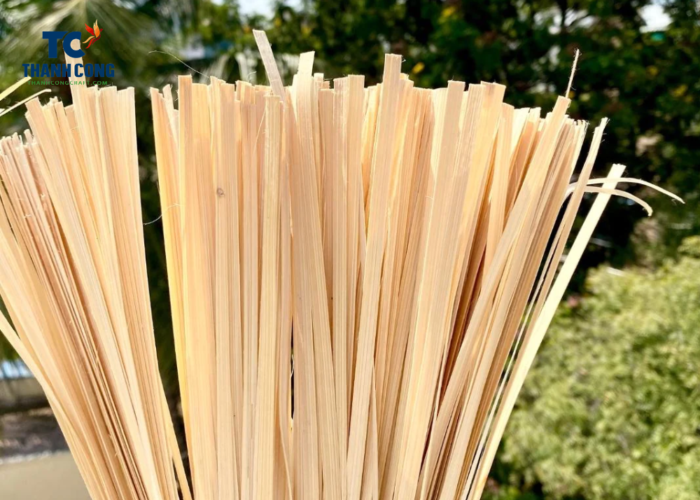
- Wash the Bamboo Skin: Remove dust and resin from the bamboo skin by washing it with water. A brush or cloth can be used to scrub the skin clean.
- Dry the Bamboo Skin: Place the bamboo skin under the sun for 2-3 days until completely dry. Flip the skin periodically to ensure even drying, considering weather conditions and humidity.
- Cut into Strands: Use a knife to slit across the width of the bamboo skin, cutting it into thin, even strands. Vary the widths based on your weaving project’s requirements.
- Soften the Bamboo Skin: Soak the bamboo skin in warm water or steam it for 15-20 minutes to make it flexible and easy to bend.
- Squeeze Dry: Immediately after soaking or steaming, squeeze the bamboo skin dry using your hands or a machine to prevent moisture and mold.
- Begin Weaving: Utilize the prepared bamboo skin to weave various products such as trays, baskets, lanterns, artificial flowers, decorations, and more.
By following these meticulous steps, you’ll be well-equipped to create beautiful crafts from bamboo. Best of luck with your weaving endeavors!
1.1 What materials are used in bamboo baskets?
Bamboo baskets typically involve the use of several materials to ensure durability, flexibility, and aesthetic appeal. The primary materials used in bamboo basket weave include:
- Bamboo Strips or Splints: The main component of bamboo baskets is the bamboo itself. After the bamboo has been harvested, cured, and prepared, it is cut into thin strips or splints. These strips form the foundation of the basket, providing the structure and framework for the weaving.
- Rattan: Rattan is often used in conjunction with bamboo to add variety to the weaving pattern. These materials are flexible and can be woven between bamboo strips to create intricate designs or provide additional strength to the basket.
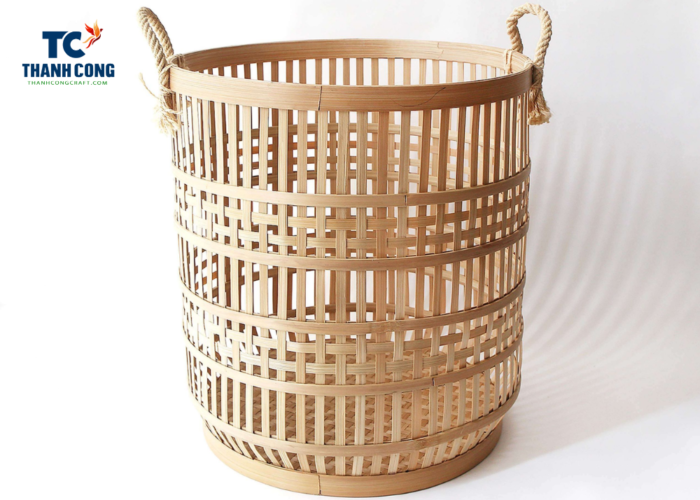
- Binding Materials: To secure the bamboo strips and other elements together, binding materials such as twine, thread, or thin strips of bamboo are commonly used. These materials help ensure the stability and integrity of the basket.
- Dyes: Artisans may use natural dyes or stains to add color to the bamboo strips, enhancing the visual appeal of the basket. This step is optional and depends on the desired aesthetic of the final product.
- Finishing Materials (optional): Some bamboo baskets may incorporate additional materials for finishing touches, such as decorative elements, handles made from bamboo or other materials, or even fabric liners to add both functionality and style.
- Sealers or Preservatives: Depending on the intended use of the basket, sealers or preservatives may be applied to protect the bamboo from moisture, insects, and environmental factors. This helps extend the lifespan of the basket.
1.2 How do you soften bamboo for weaving?
Softening bamboo for weaving is a crucial step in the preparation process, as it makes the material more flexible and easier to work with. Here’s a step-by-step guide on how to soften bamboo for weaving:
- Choose bamboo trees with suitable diameters, not too big or too small, and not cracked or crooked.
- Cut the bamboo into pieces about 1.5 meters long, then peel off the outer layer of the bamboo.
- Boil water in a large pot, then dip each piece of bamboo into the pot for about 10 minutes. This is an important step to soften the bamboo fibers and reduce their hardness.
- After dipping the bamboo into boiling water, you need to let the bamboo cool completely before continuing to process. You can leave the bamboo on a tray or a piece of clean cloth.
- Use a sharp knife or scissors to cut the bamboo lengthwise into thin strips. You should cut from the base to the tip of the bamboo, and keep the thickness of the bamboo strips uniform.
- Finally, you can use bamboo to weave into products such as towels, mats, baskets, or other items according to your preference.
2. How to make a bamboo basket?
Creating a bamboo basket is a rewarding and traditional craft that involves skillful techniques and a connection with nature. Here’s a step-by-step guide on diy how to make a bamboo basket:
Materials Needed:
- Fresh bamboo poles;
- Knife or machete;
- Twine or thin strips of bamboo for binding;
- Water and a large pot for boiling;
- Towel or clean cloth;
- Sharp scissors.
Step 1
To make a bamboo basket, you should choose good bamboo, with suitable thickness and hardness. Bamboo needs to be dried and treated to prevent termites and mold.
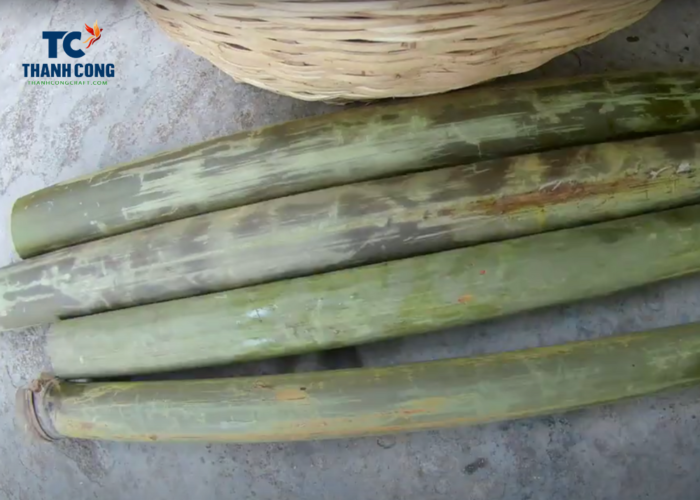
Step 2
Cut bamboo into small strips, about 1 meter long, and peel off the outer layer. Then, use a knife to shave the bamboo strips into thin fibers.
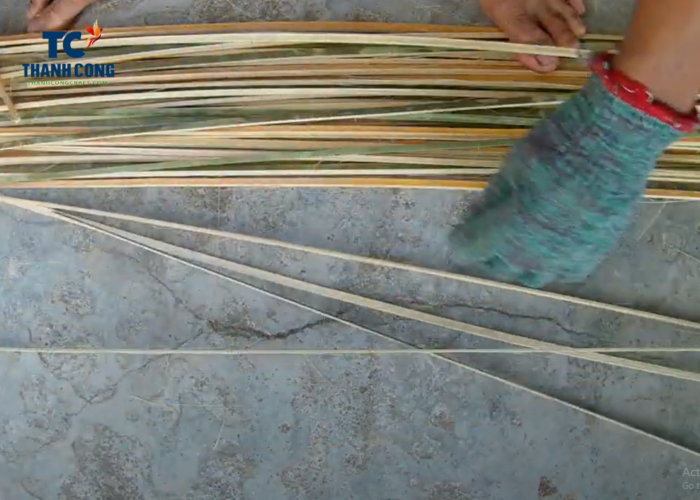
Step 3
Use rope or nylon string to tie the two ends of each bamboo fiber together, forming circular rings with the diameter equal to the desired size of the basket.
Step 4
Place the bamboo rings on top of each other, so that their joints do not overlap. Use rope or nylon string to wrap around the bamboo rings to connect them together, forming a cylindrical frame for the basket.
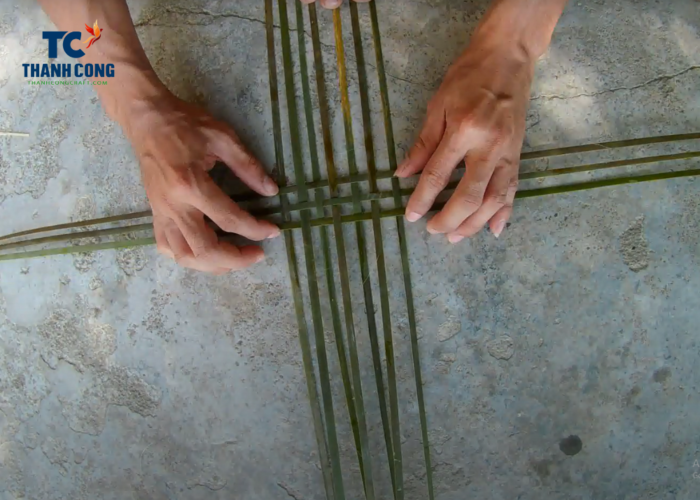
Step 5
Use the remaining bamboo fibers to weave in and out of the frame, creating the sides and bottom of the basket. You can weave in a diagonal, parallel or rectangular pattern as you like. You need to weave tightly so that the basket is not loose.
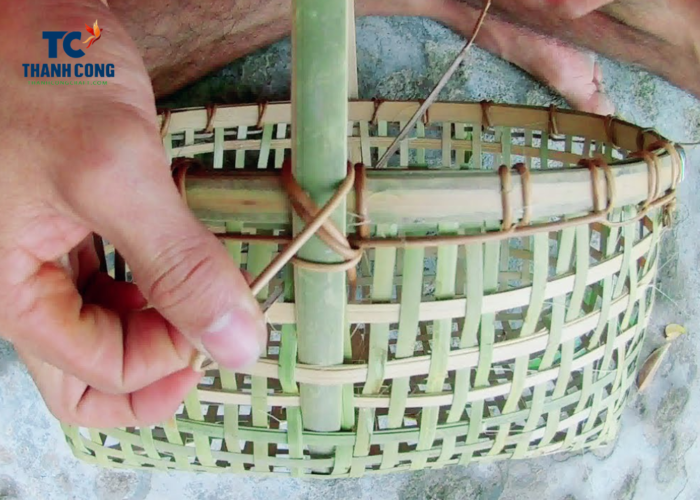
Step 6
After weaving, you can paint or apply a layer of wax on the surface of the basket to make it shiny and waterproof.
In conclusion, crafting a bamboo basket is a fulfilling and artistic endeavor that connects us with age-old traditions and the natural beauty of bamboo. Following the step-by-step guide outlined above, along with the aid of visual references, makes the process accessible and enjoyable for both beginners and seasoned artisans.
If you have any further questions, don’t hesitate to send thanhcongcraft an email us at info@thanhcongcraft.com or message us at WhatsApp: +84967485411. Hope to serve you soon! Best regard!


